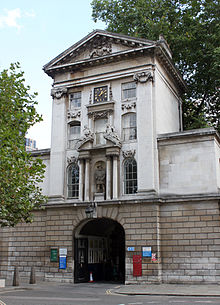St Bartholomew's Hospital

The St Bartholomew's Hospital (also known as Barts known) is a teaching hospital in London . It is located in the northwestern part of the City of London , near St Paul's Cathedral . Established in 1123, the hospital is the oldest in London and Great Britain. St Barts has 388 beds and is managed by the National Health Service . There is a close partnership with Queen Mary College at the University of London .
history
Barts was in 1123 by Rahere, a courtier and favorite of King I. Henry founded. Rahere is said to have had a vision of the Apostle Bartholomew during a pilgrimage to Rome , who asked him to establish a hospital. In the same year, the neighboring collegiate church of St Bartholomew-the-Great was founded . The dissolution of the English monasteries had no effect on the actual hospital operations, but Barts got into a difficult financial situation due to the loss of the sources of income. In December 1546, King Henry VIII re-established the hospital and signed an agreement that transferred Barts to the City of London . Letters Patent issued in January 1547 confirmed this operation and transferred new sources of income. The official, but rarely used title of the hospital was "House of the Poore in West Smithfield in the suburbs of the City of London of Henry VIII's Foundation".
In 1567 Roderigo Lopes was the first doctor to be permanently employed. Barts escaped the Great Fire of London in 1666 , but numerous properties owned by the hospital were destroyed, so that several departments had to be temporarily closed due to lack of money. From the 1730s onwards, James Gibbs rebuilt the hospital from scratch, with four identical blocks around a central plaza. It started with the north wing in 1732, followed by the south wing in 1740 (demolished in 1937) and the west wing in 1752. The east wing, which he designed and built after his death, was completed in 1769. The adjoining church tower was the only medieval building that remained. William Hogarth painted two murals in the great stairwell between 1735 and 1737, depictions of the Pool of Bethesda and the Good Samaritan.
In 1843, St Bartholomew's Hospital Medical College was founded , where doctors are trained. This training center has been integrated into Queen Mary College since 1995 . In 1994, a school for nursing and obstetrics (St Bartholomew's School of Nursing and Midwifery) was established , which has been integrated into City University since 1995 . The hospital has been part of the National Health Service since 1948 . A plaque on the wall of the hospital building commemorates the Scottish independence fighter William Wallace , who was executed in the immediate vicinity in 1305.
In 1993, the controversial Tomlinson Report concluded that there was an oversupply of hospitals in central London. The closure of St Bartholomew's Hospital was averted after a broad-based public campaign, but in 1995 the emergency room had to close. In 1998 the government confirmed that Barts would continue as a specialized center for oncology and cardiology .
Hospital museum
The Barts Museum explains the history of the hospital and its work in nursing. The museum's collection includes historical surgical instruments, archives dating back to the Middle Ages, and several works of art, including paintings by William Hogarth. The museum is located under the archway of the north wing and is open Tuesday to Friday. It is part of the London Museums of Health & Medicine network .
Sherlock Holmes and Dr. Watson
Barts and especially one of its chemistry laboratories is the place where published in 1887 novel A Study in Scarlet by Arthur Conan Doyle , the main characters Sherlock Holmes and Dr. Watson meet for the first time.
In several episodes of the television series Sherlock is the mortuary the beard scene.
Well-known alumni of St Bartholomew's Hospital Medical College
The English poet Robert Bridges completed his training as a doctor at St Bartholomew's Hospital Medical College from 1871 to 1874 and then worked there for several years before retiring to work as a solo writer. Among other things, he worked as an emergency doctor. In 1879 he wrote in a sharp report for Annalen des Hospital that he had seen 30,940 patients in his function in 1878 and had between one and 28 minutes per patient to treat them.
Web links
- St. Bartholomew's Hospital (English)
- St Bartholomew's Museum (English)
Individual evidence
- ^ A b Walter Thornbury: St Bartholomew's Hospital. In: Old and New London: Volume 2. British History Online, 1878, accessed July 31, 2012 .
- ^ A b The history of St Bartholomew's Hospital. St Bartholomew's Hospital, accessed July 31, 2012 .
- ↑ 700th Anniversary of the Execution of Sir William Wallace: 1305-2005. (No longer available online.) Laird.org, 2005, archived from the original on August 2, 2012 ; accessed on July 31, 2012 . Info: The archive link was inserted automatically and has not yet been checked. Please check the original and archive link according to the instructions and then remove this notice.
- ↑ St Bart's Hospital. In: Sherlockology. British Broadcasting Corporation, accessed July 31, 2012 .
- ^ NC Smith: Bridges, Robert Seymour in John Sutherland (ed.): Literary Lives - Intimate Biographies of the Famous by the Famous . Oxford University Press, Oxford 2002, ISBN 0-19-860642-7 . P. 43
Coordinates: 51 ° 31 ′ 2.82 ″ N , 0 ° 6 ′ 0 ″ W.
